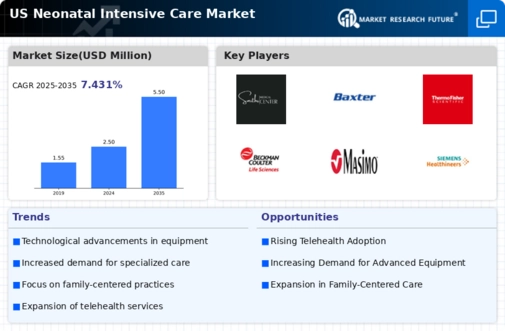Increased Healthcare Expenditure
The rising healthcare expenditure in the US is a significant driver for the neonatal intensive-care market. With healthcare spending projected to reach $6 trillion by 2027, there is a growing emphasis on improving maternal and neonatal health services. This increase in funding allows for better infrastructure, training, and resources dedicated to neonatal care. Hospitals are likely to invest in state-of-the-art facilities and equipment to provide optimal care for newborns, particularly those requiring intensive care. As a result, the neonatal intensive-care market is expected to benefit from enhanced financial support, leading to improved care delivery and outcomes for neonates.
Regulatory Support and Guidelines
Regulatory bodies in the US are increasingly focusing on improving neonatal care standards, which serves as a driver for the neonatal intensive-care market. Initiatives aimed at enhancing the quality of care for newborns, such as the Healthy People 2030 objectives, emphasize reducing infant mortality rates and improving health outcomes. These guidelines encourage healthcare providers to adopt best practices and invest in necessary resources. Compliance with these regulations often requires hospitals to upgrade their neonatal intensive-care units, thereby stimulating market growth. The emphasis on quality care and safety standards is likely to lead to a more robust neonatal intensive-care market, as facilities strive to meet regulatory expectations.
Advancements in Medical Technology
Innovations in medical technology are significantly influencing the neonatal intensive-care market. The introduction of advanced monitoring systems, incubators, and respiratory support devices has improved the survival rates of critically ill neonates. For instance, the use of non-invasive ventilation techniques has been shown to reduce the need for intubation, thereby minimizing complications. The market for neonatal medical devices is projected to reach approximately $3 billion by 2026, reflecting a compound annual growth rate (CAGR) of around 6%. These advancements not only enhance patient outcomes but also drive the demand for skilled healthcare professionals trained in the latest technologies, further propelling the growth of the neonatal intensive-care market.
Rising Prevalence of Premature Births
The increasing incidence of premature births in the US is a critical driver for the neonatal intensive-care market. According to the CDC, approximately 10% of all live births are preterm, necessitating specialized care. This trend is likely to continue, as factors such as maternal age and health conditions contribute to higher rates of premature deliveries. The neonatal intensive-care market is positioned to expand, as healthcare facilities must enhance their capabilities to manage the complexities associated with preterm infants. The demand for advanced neonatal care technologies and services is expected to rise, potentially leading to a market growth rate of around 5% annually. This situation underscores the importance of investing in neonatal intensive-care resources to address the needs of this vulnerable population.
Growing Awareness of Neonatal Health Issues
There is a growing awareness of neonatal health issues among parents and healthcare providers, which is positively impacting the neonatal intensive-care market. Educational campaigns and community outreach programs are increasing knowledge about the importance of early intervention and specialized care for newborns. This heightened awareness is likely to lead to earlier hospital visits and increased demand for neonatal services. As parents become more informed about the risks associated with prematurity and other neonatal conditions, they are more inclined to seek specialized care, thereby driving the growth of the neonatal intensive-care market. This trend suggests a potential increase in service utilization, further emphasizing the need for comprehensive neonatal care solutions.



















Leave a Comment